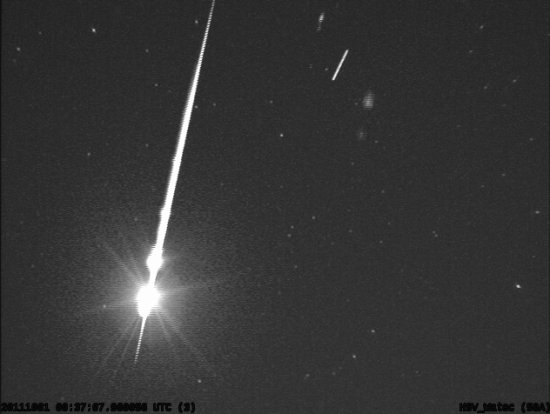Fireball & Space Junk Light Up Alabama Sky in Cosmic Double Play

A NASA camera that scans the night sky for meteors caught a stunning double feature when it spotted a fiery meteor breaking apart while a piece of an old Russian rocket zoomed overhead.
The space light show occurred Friday (Sept. 30) over NASA's Marshall Space Flight Center in Huntsville, Ala., at about 8:37 p.m. EDT (0037 GMT). A wide-field meteor camera, one of many in a network NASA uses to track fireballs, recorded the "spectacular meteor breaking up in Earth's atmosphere," according to a blog post by meteor scientist Bill Cooke,head of NASA's Meteoroid Environments Office at the Marshall center.
A NASA video of the meteor's fireball posted today (Oct. 5) shows the event. But the camera also recorded an extra surprise. [See video and photo of the fireball and space junk]
"Also visible is a star-like object moving slowly toward the upper middle of the field of view — the upper stage of the Zenit booster that launched the Russian Cosmos 2219 intelligence satellite back in 1992," Cooke wrote. "Orbiting 500 miles above Earth, this empty rocket body can get bright enough to be seen with the unaided eye."
In the video, the rocket body appears as a tiny dot of light near the top of the field of view, drifting to the upper right. The meteor, meanwhile, streaks down across the left side of the frame in a dazzling fireball. The entire event lasts just four seconds.
Seeing a satellite sail across the sky is not uncommon. Many satellites can be seen with the unaided eye for skywatchers who know when and where to look. The largest and brightest is the International Space Station, which can sometimes rival the planet Venus in brightness.
The fireball and space junk sighting occurred about a week ahead of the annual October Draconid meteor shower, which is expected to unleash a potential meteor storm this weekend when it peaks on Saturday (Oct. 8).
Breaking space news, the latest updates on rocket launches, skywatching events and more!
Cooke did not specify in his post if the fireball caught on Sept. 30 was a rogue space rock or an early Draconid display.
This year, the peak of the Draconid meteor shower will not be visible from the United States because it will occur primarily during the daylight hours. Skywatchers in the Eastern Hemisphere are better placed to see the meteor shower, though the nearly full moon could wash out the cosmic fireworks, NASA scientists have said.
Editor's note: If you snap amazing Draconid meteor photos you'd like to share for a possible story or image gallery on SPACE.com, please contact managing editor Tariq Malik at tmalik@space.com.
You can follow SPACE.com Managing Editor Tariq Malik on Twitter @tariqjmalik. Follow SPACE.com for the latest in space science and exploration news on Twitter @Spacedotcom and on Facebook.

Tariq is the award-winning Editor-in-Chief of Space.com and joined the team in 2001. He covers human spaceflight, as well as skywatching and entertainment. He became Space.com's Editor-in-Chief in 2019. Before joining Space.com, Tariq was a staff reporter for The Los Angeles Times covering education and city beats in La Habra, Fullerton and Huntington Beach. He's a recipient of the 2022 Harry Kolcum Award for excellence in space reporting and the 2025 Space Pioneer Award from the National Space Society. He is an Eagle Scout and Space Camp alum with journalism degrees from the USC and NYU. You can find Tariq at Space.com and as the co-host to the This Week In Space podcast on the TWiT network. To see his latest project, you can follow Tariq on Twitter @tariqjmalik.
